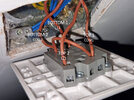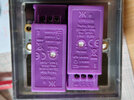Hi,
I have never come across this before, so I hope you can give me some direction here. I can normally swap switches and sockets without changing any configuration, but it didn't quite work out this time around. I always mark cables and take photos.
I have 2 lights in the main bedroom upstairs with a standard on/off switch (no other switch in the bedroom). I put on dimmable led bulbs, and I wanted to install a dimmer switch (2G). Didn't quite go according to plan.
First thing I noticed is that when the bedroom switch is disconnected, other bedroom and toilet lights don't work. Somehow, entire first floor lights depend on the bedroom switch. Is this normal?? I found this a bit strange.
Secondly, please see a photo of the original switch setup (untouched). I put lines on the cables to ensure I can revert back (and I had to). For ease, I noted them as Top1, Top2, and Bottom1, Bottom 2. I would really appreciate it if you can let me know what the correct configuration is on the new dimmer switch. I tried replicating the same setup (although I wasn't sure about the L11 L12 L21 L22, which didn't correspond with the simpler L1 L2) but it either didn't turn any lights at all, or it turned on/off other rooms lights (I left them switched on).
I hope I explained this correctly, but if you require any clarification please let me know.
Thank you very much in advance!
I have never come across this before, so I hope you can give me some direction here. I can normally swap switches and sockets without changing any configuration, but it didn't quite work out this time around. I always mark cables and take photos.
I have 2 lights in the main bedroom upstairs with a standard on/off switch (no other switch in the bedroom). I put on dimmable led bulbs, and I wanted to install a dimmer switch (2G). Didn't quite go according to plan.
First thing I noticed is that when the bedroom switch is disconnected, other bedroom and toilet lights don't work. Somehow, entire first floor lights depend on the bedroom switch. Is this normal?? I found this a bit strange.
Secondly, please see a photo of the original switch setup (untouched). I put lines on the cables to ensure I can revert back (and I had to). For ease, I noted them as Top1, Top2, and Bottom1, Bottom 2. I would really appreciate it if you can let me know what the correct configuration is on the new dimmer switch. I tried replicating the same setup (although I wasn't sure about the L11 L12 L21 L22, which didn't correspond with the simpler L1 L2) but it either didn't turn any lights at all, or it turned on/off other rooms lights (I left them switched on).
I hope I explained this correctly, but if you require any clarification please let me know.
Thank you very much in advance!



